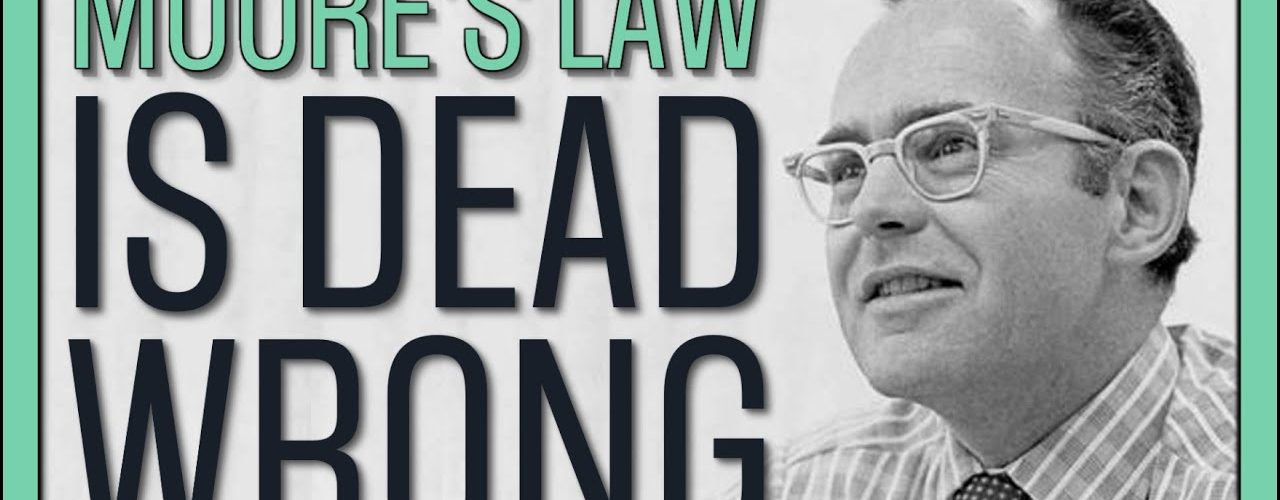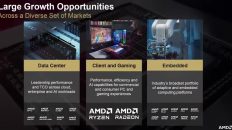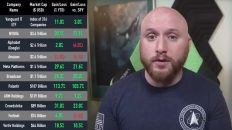Mentioned in Video:
- ARK Invest features Wright's Law extensively in their research and publications.
- ARK Invest's 5 actively managed ETFs are themed around 5 innovations that have hit a critical growth point according to Wright's Law (not Moore's Law):
- ARK Invest Innovation ETF (ARKK) – https://ark-funds.com/arkk
- ARK Invest Autonomous Technology & Robotics ETF (ARKQ) – https://ark-funds.com/arkq
- ARK Invest Next Generation Internet ETF (ARKW) – https://ark-funds.com/arkw
- ARK Invest Fintech Innovation ETF (ARKF) – https://ark-funds.com/fintech-etf
- ARK Invest Genomic Revolution ETF (ARKG) – https://ark-funds.com/arkg
- The Singularity is Near by Ray Kurzweil: https://www.amazon.com/Singularity-Near-Humans-Transcend-Biology/dp/0143037889/
- The Tipping Point by Malcolm Gladwell: https://www.amazon.com/Tipping-Point-Little-Things-Difference/dp/0316346624/
- Support the channel and get extra member-only benefits by joining us on Patreon: https://www.patreon.com/tickersymbolyou
Moore's Law isn't just dead, it's wrong. In this video, I look at another fundamental law #ARKInvest uses to find disruptive technologies and pick innovative companies like #Tesla (#TSLA) way before Wall Street buys in. Tesla remains #ARK Invest's biggest holding by a large margin and there's no doubt that it follows Wright's Law, the focus of this video. This context is important when we look at how ARK Invest navigates the markets as active fund managers and analyze their five thematic ETFs (#ARKK, ARKG, ARKW, ARKQ, ARKF), which are based on disruptive innovations that have hit “escape velocity” according to #CathieWood. This video answers exactly what that means.
I am not a financial advisor or affiliated with ARK Invest in any way.
Thanks for watching!
Video Transcript:
[00:00:00.210]
Hey there, Alex here. Welcome back to Ticker Symbol: You, the channel that invests in you. In this video, we're going to take a look at another one of those laws that governs how ARK Invest picks their stocks and times their picks. The law I'm talking about isn't Moore's Law. It's actually Wright's law. So we'll take a look at the difference between the two and the impact they've had on ARK Invest. A lot of research and effort goes into making each one of these videos and you can find all of my sources in the description below.
[00:00:28.410]
So I'd appreciate your early thumbs up and let's dive right in. When I was getting my undergrad degree in electrical engineering, I learned all about Moore's Law. So who is Gordon Moore and what exactly is his law? Gordon Moore is an American businessman, engineer and the co-founder of Intel. And in 1965, he observed and correctly predicted that the number of components in an integrated circuit would continue to double every two years. So here's a rough timeline decade by decade of what that looks like.
[00:00:59.040]
In the 1950s, we didn't really have circuits. We had individual transistors. And in the 1960s we had a simple circuit of about 16 transistors. By the 1970s, that was a microprocessor with about 4500 transistors, so on and so forth until today, when we're talking about circuits with eight billion transistors. And Gordon Moore predicted the pace of this progress in 1965.
[00:01:24.900]
I don't know how to put this, but I'm kind of a big deal.
[00:01:31.050]
So here's a plot of Moore's Law and action. Remember, Moore's Law says the part count on an integrated circuit is going to roughly double every two years. That's about a forty two percent compound annual growth rate. So what you're seeing here on the Y axis is the part count. And on the x axis, we just have time. And each one of these dots represents the state of the art integrated circuit and its part count. The line represents Moore's Law.
[00:01:58.350]
This appears to be an amazing prediction. Pretty good, right? So what's the problem? Well, here's what ARK Invest thinks.
[00:02:06.750]
I don't believe you.
[00:02:07.800]
So one more time. Moore's Law says that the component rate on an integrated circuit will double every two years. And ARK Invest argues that time isn't what drive costs down. Production is. Another way of saying this is Moore's Law assumes a constant relationship between cost and demand. ARK Invest claims that Moore's Law has not withstood the test of time.
[00:02:30.360]
Moore's Law assumes that over time, demand and thus production volume would keep increasing as price continues to decline. But the growth in production has slowed dramatically over the course of the last decade, and so too has the change in price. So while everyone else is proclaiming the end of Moore's Law, ARK Invest suggests that it's been flawed all along. So here's another plot of Moore's Law over time. On the X axis, we have time and on the Y axis, we have performance, which is basically a function of transistor count.
[00:03:03.600]
And what you're seeing here in Orange is Moore's Law. And in red, you're seeing the curve that actually best represents part count over time. And you can see that for a long time, they're pretty close. Of course, in the beginning, there was a ramp up period resulting in the difference between the orange line and the red line. But as you can see lately, the red line and the orange line are diverging again. This is what ARK is talking about, a slowing down in the increase of part counts on an integrated circuit over time.
[00:03:33.510]
If Moore's Law held true forever, the red curve and the yellow line would match up perfectly. So let's zoom out and see if we can better understand the flaws associated with Moore's Law. This is what's called an S curve. If you don't know what that is yet, don't worry. By the end of this video, you will. The shape of this curve is fundamental to how ARK Invest spots investment opportunities. In the beginning of the life cycle of any technology,
[00:03:59.580]
you have some initial ramp up phase. Things still cost a lot, so it's hard to produce things in mass quantities. Eventually, the production of a given technology gains momentum and production increases over time. The line in yellow again represents Moore's Law. It's easy to mistake this portion for a line. As technologies continue to grow and mature, they start bumping up against some fundamental limits. In Intel's example, they're having trouble developing their seven nanometer chips exactly because it's very hard to keep making parts smaller and smaller forever.
[00:04:32.850]
The slope of this line is fixed at doubling every two years, which implies that eventually part count must approach infinity. And as you, me and Gordon Moore are aware, that can't happen. So if Moore's Law is wrong, who do we turn to? ARK Invest suggests we turn to Wright's Law. Wright's Law is a framework for forecasting cost declines as a function of cumulative production. It states that for every cumulative doubling costs will fall by a constant percentage.
[00:05:01.990]
So let's go through an example of that now. Let's say it costs us a thousand dollars to produce the first 1000 of something. And let's say the constant percentage decline is 10 percent to produce the next thousand of something or cumulatively double it. It should only cost us nine hundred dollars, so on and so on. For each cumulative doubling, costs fall by 10 percent. So what's the difference between Wright's Law and Moore's Law? Moore's Law focuses on cost as a function of time.
[00:05:32.080]
It states that the number of transistors on a chip will double every two years. So no matter when in time we look, as long as two years pass, we should be expecting the number of transistors on a circuit to double. This is obviously not the case. Wright's Law, on the other hand, forecasts costs as a function of units produced. So according to ARK Invest, Moore's Law is wrong and Wright's Law is right more of the time.
[00:05:59.200]
And that's what you're seeing in this plot here. On the x axis, we have time every two years and on the Y axis, we have the percentage increase in the number of transistors. And if Moore's Law is right, then every two years the number of transistors should increase by one hundred percent. The Green Line represents what actually happened in those years. So the differences between the green line and the red line at any given time are the errors in Moore's Law.
[00:06:26.740]
In fact, looking back throughout history from 2005 to 2015, ARK Invest found out that Wright's Law was 40 percent more accurate than Moore's Law. And that's exactly what this plot is showing you here. When looking at the amount of transistors on an integrated circuit throughout history, you can compare how accurate Wright's Law is and Moore's Law is at predicting that transistor count. When this line is above zero, Wright's Law did a better job predicting transistor counts on a circuit than Moore's Law.
[00:06:55.630]
When the line is below zero, Moore's Law did the better job. Not only is this line mostly above zero, but lately it's increasing in Wright's Law's favor. It's important to note that Wright's Law is not without its own challenges. Challenge number one is that Wright's Law means a lot of historical data and not just recent data to be an accurate predictor. So the more data you have, the better it becomes. Compare that to Moore's Law, where as long as you have two data points, you should be able to predict the decline every two years.
[00:07:26.530]
The second challenge involved with Wright's Law is you need to understand how demand is affected by cost. For example, demand does not increase in a straight line as a function of cost. There's actually a tipping point. As your costs begin to decline, you increase your total addressable market. Think about if your favorite car was twenty five percent cheaper. The amount of people who could afford it maybe almost doubles. So the link between cost and demand isn't fixed.
[00:07:55.090]
In fact, it's exponential. This is the fundamental problem with Moore's Law that Wright's Law addresses. So here's ARK Invest's special sauce broken down into its components. Let me walk you throughit. It's production, not time, that dictates cost. As costs go down, adoption rate goes up, but not in a straight line. You hit some critical tipping point where the cost is cheap enough for mass adoption. Adoption increases demand. For example, when your buddy gets that new Xbox or PlayStation, everyone around him wants one, too.
[00:08:30.070]
And as long as there's an increase in demand, there will be an increase in production. And now we're back to the start of the cycle, it's production, and not time, that further drives down costs. That's actually only two thirds of the picture. What we just covered is that costs continue to decline. That ramps up production, which hits a critical point, which eventually greatly accelerates the reduction of cost. Part two is about the cross-sector adoption of that technology.
[00:08:58.630]
So as integrated circuits became cheaper, they got adopted in more and more industries at different rates over time. The final piece is that there's innovation on top of innovations. Think about all of the technologies that you use today that rely on lithium ion batteries or integrated circuits: transportation, communication, advanced robotics, self-driving cars and entertainment. And now the cycle begins anew where all these technologies have their own cost curve declines, their own adoption rates and their own innovations that spawn on top of them.
[00:09:36.250]
Now, let's come full circle back to that S curve. Let's just use energy storage as an example. In the beginning, we had a big bulky lead acid batteries. Then over time, we developed alkaline batteries and these batteries had about triple the energy density of lead acid batteries. Then we moved to nickel metal hydride and finally, lithium ion. Each one of these different battery types enabled new types of devices to be built on top of them, whether we're talking about watches or car batteries or the modern smartphone, and eventually a given technology hits what Cathie Wood terms escape velocity.
[00:10:16.720]
First thing I'll say is that the innovation that is in place right now, based on the five major innovation platforms around which we've based all of our research, and they involve 14 different technologies, those have hit escape velocity. They are on their way.
[00:10:35.140]
Escape velocity is where the cycle of innovation has occurred enough times that a given technology is able to penetrate most market sectors. For example, in the case of lithium ion batteries, almost every major market sector has adopted it as the means of storing energy. So the next question we should ask ourselves is which technologies does Cathie Wood and ARK Invest think have hit this escape velocity? And that's exactly why ARK Invest's five actively managed ETFs have the themes of DNA sequencing, energy storage, robotics, artificial intelligence and blockchain technology.
[00:11:12.910]
So this is ARK Invest's secret sauce. They understand these cycles of innovation better than anyone else and they can spot these technologies before they hit that escape velocity. ARK Invest is pretty special. They make their sauce recipes, by which I mean their investment process openly available to anyone looking for it. In addition, they released tons and tons of content on their YouTube and directly on their website, including which technologies they're constantly following. And even the article that this video is based on, “Moore's Law Isn't Dead It's Wrong” is an article by Brett Winson. Two books that I would recommend to any investor interested in Disruptive Innovation are “The Singularity Is Near” by Ray Kurzweil, which really focuses on the breakneck pace of innovation and “The Tipping Point” by Malcolm Gladwell, which looks at the adoption rate of different ideas and technologies throughout history
[00:12:05.260]
over time. If you've made it to the end, you're awesome. This is Ticker Symbol: You. My name is Alex, reminding you that the best investment you can make is in you.
If you want to comment on this, please do so on the YouTube Video Here














